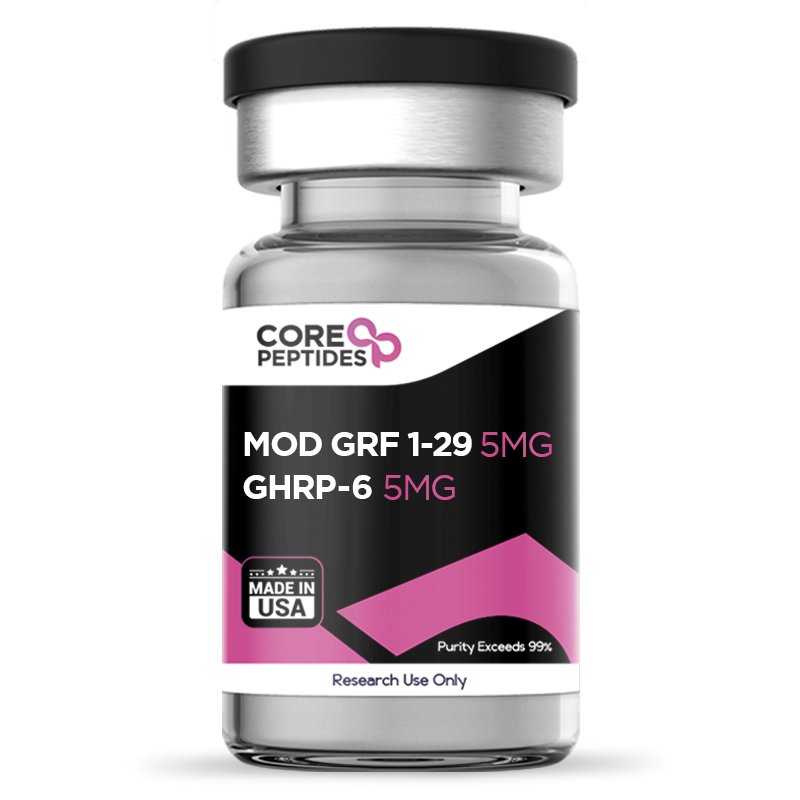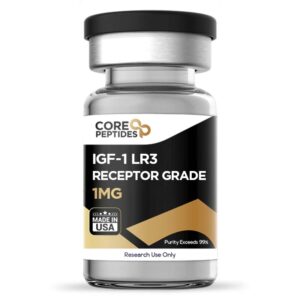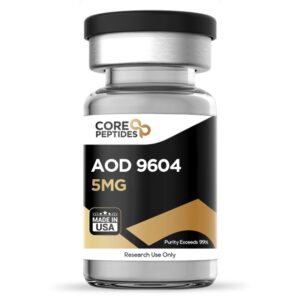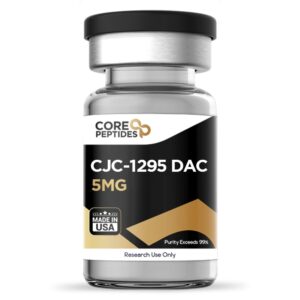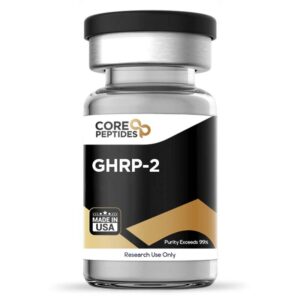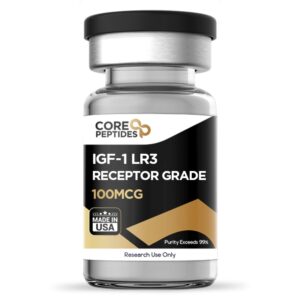Mod GRF 1-29 & GHRP-6 Blend (10mg)
$75.00
Size: 10mg
Contents: Mod GRF 1-29 (5mg) & GHRP-6 (5mg)
Form: Lyophilized powder
Purity: >99%
SKU: GRF-1-29-GHRP-6
FREE Shipping on $200+ orders
Discount per Quantity
| Quantity | Discount | Price |
|---|---|---|
| 5 - 8 | 5% | $71.25 |
| 9 + | 10% | $67.50 |
Mod GRF 1-29 & GHRP-6 Peptide Blend
GHRP-6 (Growth Hormone Releasing Peptide-6) is a synthetic peptide developed to stimulate the release of growth hormone from the pituitary gland by mimicking the effects of ghrelin. It is classified as ghrelin mimetic or GHS (growth hormone secretagogue). It is composed of six amino acids and is classified as a hexapeptide. GHRP-6 has been studied to explore its potential action, which includes possible mitigation of growth hormone deficiency and cachexia (muscle wasting).(1)
Modified (Mod) GRF 1-29, also known as CJC-1295 without DAC (Drug Affinity Complex), is a synthetic peptide developed to act as a growth hormone-releasing hormone (GHRH) analog. It comprises 29 amino acids and is a tetrasubstituted version of the GRF 1-29 (Growth-Releasing Factor). GRF 1-29 is the smallest fragment of the GHRH peptide sequence, which may have the same potential for stimulating growth hormone release.
Chemical Makeup
Molecular Formula:
- Mod GRF 1-29: C152H252N44O42
- GHRP-6: C46H56N12O6
Molecular Weight:
- Mod GRF 1-29: 3367.95 g/mol
- GHRP-6: 873.03 g/mol
Other Known Titles
- Mod GRF 1-29: CJC-1295 NO DAC; tetrasubstituted GRF 1-29
- GHRP-6: Growth Hormone Releasing Peptide-6
Research and Clinical Studies
Mod GRF 1-29 & GHRP-6 Peptide and the Pituitary
Mod GRF 1-29 and GHRP-6 has been suggested by researchers to work to upregulate growth hormone and insulin-like growth factor-1 (IGF-1) by activating the GHRH-receptors and the ghrelin receptors, respectively.(2) Mod GRF 1-29 appears to bind to the GHRH receptors on somatotroph cells in the anterior pituitary gland. It is hypothesized that this binding might be a potential trigger for subsequent intracellular events that possibly lead to growth hormone release. Upon binding to the receptors, Mod GRF 1-29 may potentially initiate a series of intracellular signaling cascades.(2) One pathway that appears to be activated is the adenylyl cyclase pathway, which might lead to the conversion of ATP (adenosine triphosphate) into cAMP (cyclic adenosine monophosphate). The rise in cAMP levels may possibly activate protein kinase A (PKA). This activation may result in the phosphorylation of various proteins, including the voltage-dependent calcium channels on the cell membrane.
It is posited that the phosphorylation and potential opening of these calcium channels allow calcium ions to flow into the somatotropic cells. Elevated intracellular calcium concentrations are believed to play a role in subsequent steps of growth hormone release. It has also been hypothesized that high intracellular calcium concentrations may stimulate the secretory vesicles within the somatotroph cells to release growth hormone into the circulation. On the other hand, GHRP-6 has been suggested by researchers to bind to and potentially activate the ghrelin receptor, known as GHS-R1a (Growth Hormone Secretagogue Receptor 1a), which might hypothetically cause the release of growth hormone. GHRP-6 is believed to be a synthetic hexapeptide that may have a high affinity for the GHS-R1a.(3) Upon binding, GHRP-6 appears to induce a hypothetical conformational change, potentially activating the receptor.
The apparent binding of GHRP-6 to GHS-R1a might activate several intracellular signaling pathways. One pathway that seems to be activated is the phospholipase C (PLC) pathway, which might lead to the production of inositol trisphosphate (IP3) and diacylglycerol (DAG). IP3 which then may initiate the release of calcium from intracellular stores, possibly leading to a rise in intracellular calcium levels. This increase in calcium is posited to play a role in the release of GH from the pituitary.
Mod GRF 1-29 & GHRP-6 Peptide and Potential Synergism
It is hypothesized that GHRP-6 may exert a synergistic effect when introduced alongside Mod GRF 1-29. While both GHRP-6 and Mod GRF 1-29 have been suggested to potentially stimulate GH release individually, their combined effect appears to be more significant than their individual impacts. This suggests that GHRP-6 and Mod GRF 1-29 might influence different somatotroph populations or that they may affect different phases of the growth hormone release process.
Several studies suggest the existence of such synergisms. For example, one study reported an apparent increase in IGF-1 levels of over 65% after the combined introduction of GHRP-6 and the unmodified version of Mod GRF 1-29.(4) In comparison, previous research has suggested that Mod GRF 1-29 may potentially lead to a 27-28% increase in IGF-1, which is considerably lower increase.(5) A subsequent study appears to suggest that the original, possibly unaltered version of Mod GRF 1-29, which may be akin to native GHRH, potentially led to a 20-fold surge in pulsatile growth hormone release. At the same time, a GHRP that seems similar to GHRP-6 was apparently observed to cause a 47-fold rise in pulsatile growth hormone levels. Interestingly, when GHRH and GHRP were possibly combined, the mixture may have resulted in a 54-fold increase in pulsatile GH release compared to baseline, which may hint at a synergistic effect. This combination might, in theory, offer enhanced stimulation of growth hormone secretion.(6)
Mod GRF 1-29 & GHRP-6 Peptide and Muscle Mass
GHRP-6 and Mod GRF 1-29 have been suggested by researchers to exert anabolic properties by increasing growth hormone levels. For example, clinical studies with GRF 1-29 suggest that it may increase nocturnal growth hormone levels, serum levels of IGF-I and IGFBP-3, and GHBP concentrations.(5) As a result, male test subjects who were presented the peptide for four months reportedly experienced a significant increase in lean body mass by 1.26 kg. The peptide also appeared to induce a possible increase in skin thickness in male subjects and possible improved insulin sensitivity.
Another trial supported the hypothesis that GRF (1-29) might increase GH and IGF-I levels and improve skeletal muscle function and metabolism in ambulatory, non-obese subjects aged 64 to 76 years with low baseline IGF-I.(7) More specifically, GRF (1-29) appeared to increase mean nocturnal GH release, GH peak amplitude, and two measures of muscle strength and a muscle endurance test.
GHRP-6 also may have anabolic potential, according to certain study findings. This potential is likely mediated via its alleged growth hormone and IGF-1 stimulating action. One experiment with cultured myoblast cells reported that the peptide appeared to increase the expression of myogenic marker proteins, insulin-like growth factor-1, collagen type I, and metabolic activity in the myoblasts.(8) Thus, the scientists concluded that the peptide GHRP-6 might improve muscle condition by stimulating collagen type I synthesis and key proteins.
Mod GRF 1-29 & GHRP-6 Peptide and Growth Hormone Deficiency
GRF 1-29 and GHRP-6 have been investigated for their potential to stimulate growth in models of growth hormone deficiencies. One clinical study investigated the potential of GRF 1-29 for growth hormone deficiency.(9) In total, 110 subjects were presented with the peptide once daily for up to one year, and the main outcomes measured were linear growth enhancement and bone age progression. The peptide appeared to exhibit a significant increase in height velocity, with 74% of the subjects having a reportedly enhanced response after six months. The bone age to height age ratio was reported to remain stable. The researchers concluded, “No change in fasting glucose concentration or excessive generation of insulin-like growth factor I occurred, and overall GHRH was well tolerated.”
Another clinical trial aimed to investigate the potential of GHRP-6 in stimulating growth hormone (GH) secretion in subjects with normal height.(10) The study included 13 subjects, and the results suggested that the GH response to GHRP-6 was reportedly significant and comparable to that of other GHSs.
Mod GRF 1-29 & GHRP-6 Peptide and Wasting, Cachexia
Mod GRF 1-29 and GHRP-6 reportedly exhibits some potential to increase growth hormone and IGF-1 levels, which may have anti-catabolic actions on muscle tissue. For example, GRF 1-29 was suggested to significantly increase growth hormone peak levels in research models, even though the potential appeared slightly attenuated in those with growth hormone deficiency.(11) Despite no direct research on Mod GRF 1-29 (without DAC), studies on Mod GRF 1-29 with DAC report apparently increased HGH and IGF-1 levels in the test subjects.(12)
GHRP-6 may also cause a dramatic increase in growth hormone levels, according to researchers in clinical trials. For example, Cordido et al. suggested that GHRP-6 might increase GH secretion in 19 obese subjects.(13) The scientists noted that GHRP-6 appeared more impactful than GHRH alone, stating, “GH responses to GHRP-6 were almost twice those to GHRH in obese patients.” GHRP-6 was developed with the intention of having potential as a ghrelin mimetic. Studies suggest that mimetics have shown promise in reversing protein breakdown and weight loss in catabolic states.(14) Ghrelin has various potential actions on regulating appetite, body composition, growth hormone secretion, and energy expenditure. It may also have anti-inflammatory, anti-apoptotic, and anxiolytic potential as well.
Mod GRF 1-29 & GHRP-6 peptide is available for research and laboratory purposes only. Please review and adhere to our Terms and Conditions before ordering.
References:
- Cabrales, A., Gil, J., Fernández, E., Valenzuela, C., Hernández, F., García, I., Hernández, A., Besada, V., Reyes, O., Padrón, G., Berlanga, J., Guillén, G., & González, L. J. (2013). Pharmacokinetic study of Growth Hormone-Releasing Peptide 6 (GHRP-6) in nine healthy male volunteers. European journal of pharmaceutical sciences : official journal of the European Federation for Pharmaceutical Sciences, 48(1-2), 40–46. https://doi.org/10.1016/j.ejps.2012.10.006
- Sinha, D. K., Balasubramanian, A., Tatem, A. J., Rivera-Mirabal, J., Yu, J., Kovac, J., Pastuszak, A. W., & Lipshultz, L. I. (2020). Beyond the androgen receptor: the role of growth hormone secretagogues in the modern management of body composition in hypogonadal males. Translational andrology and urology, 9(Suppl 2), S149–S159. https://doi.org/10.21037/tau.2019.11.30
- Abizaid, A., & Hougland, J. L. (2020). Ghrelin Signaling: GOAT and GHS-R1a Take a LEAP in Complexity. Trends in endocrinology and metabolism: TEM, 31(2), 107–117. https://doi.org/10.1016/j.tem.2019.09.006
- Sigalos, J. T., Pastuszak, A. W., Allison, A., Ohlander, S. J., Herati, A., Lindgren, M. C., & Lipshultz, L. I. (2017). Growth Hormone Secretagogue Treatment in Hypogonadal Men Raises Serum Insulin-Like Growth Factor-1 Levels. American journal of men's health, 11(6), 1752–1757. https://doi.org/10.1177/1557988317718662
- Khorram, O., Laughlin, G. A., & Yen, S. S. (1997). Endocrine and metabolic effects of long-term administration of [Nle27]growth hormone-releasing hormone-(1-29)-NH2 in age-advanced men and women. The Journal of clinical endocrinology and metabolism, 82(5), 1472–1479. https://doi.org/10.1210/jcem.82.5.3943
- Veldhuis, J. D., & Keenan, D. M. (2008). Secretagogues govern GH secretory-burst waveform and mass in healthy eugonadal and short-term hypogonadal men. European journal of endocrinology, 159(5), 547–554. https://doi.org/10.1530/EJE-08-0414
- Vittone, J., Blackman, M. R., Busby-Whitehead, J., Tsiao, C., Stewart, K. J., Tobin, J., Stevens, T., Bellantoni, M. F., Rogers, M. A., Baumann, G., Roth, J., Harman, S. M., & Spencer, R. G. (1997). Effects of single nightly injections of growth hormone-releasing hormone (GHRH 1-29) in healthy elderly men. Metabolism: clinical and experimental, 46(1), 89–96. https://doi.org/10.1016/s0026-0495(97)90174-8
- Lim, C. J., Jeon, J. E., Jeong, S. K., Yoon, S. J., Kwon, S. D., Lim, J., Park, K., Kim, D. Y., Ahn, J. K., & Kim, B. W. (2015). Growth hormone-releasing peptide-biotin conjugate stimulates myocytes differentiation through insulin-like growth factor-1 and collagen type I. BMB reports, 48(9), 501–506. https://doi.org/10.5483/bmbrep.2015.48.9.258
- Thorner, M., Rochiccioli, P., Colle, M., Lanes, R., Grunt, J., Galazka, A., Landy, H., Eengrand, P., & Shah, S. (1996). Once daily subcutaneous growth hormone-releasing hormone therapy accelerates growth in growth hormone-deficient children during the first year of therapy. Geref International Study Group. The Journal of clinical endocrinology and metabolism, 81(3), 1189–1196. https://doi.org/10.1210/jcem.81.3.8772599
- Bellone, J., Ghizzoni, L., Aimaretti, G., Volta, C., Boghen, M. F., Bernasconi, S., & Ghigo, E. (1995). Growth hormone-releasing effect of oral growth hormone-releasing peptide 6 (GHRP-6) administration in children with short stature. European journal of endocrinology, 133(4), 425–429. https://doi.org/10.1530/eje.0.1330425
- Achermann, J. C., Hindmarsh, P. C., Robinson, I. C., Matthews, D. R., & Brook, C. G. (1999). The relative roles of continuous growth hormone-releasing hormone (GHRH(1-29)NH2) and intermittent somatostatin(1-14)(SS) in growth hormone (GH) pulse generation: studies in normal and post cranial irradiated individuals. Clinical endocrinology, 51(5), 575–585. https://doi.org/10.1046/j.1365-2265.1999.00839.x
- Teichman, S. L., Neale, A., Lawrence, B., Gagnon, C., Castaigne, J. P., & Frohman, L. A. (2006). Prolonged stimulation of growth hormone (GH) and insulin-like growth factor I secretion by CJC-1295, a long-acting analog of GH-releasing hormone, in healthy adults. The Journal of clinical endocrinology and metabolism, 91(3), 799–805. https://doi.org/10.1210/jc.2005-1536
- Sigalos, J. T., & Pastuszak, A. W. (2018). The Safety and Efficacy of Growth Hormone Secretagogues. Sexual medicine reviews, 6(1), 45–53. https://doi.org/10.1016/j.sxmr.2017.02.004
- Khatib, M. N., Gaidhane, A., Gaidhane, S., & Quazi, Z. S. (2018). Ghrelin as a Promising Therapeutic Option for Cancer Cachexia. Cellular physiology and biochemistry : international journal of experimental cellular physiology, biochemistry, and pharmacology, 48(5), 2172–2188. https://doi.org/10.1159/000492559
